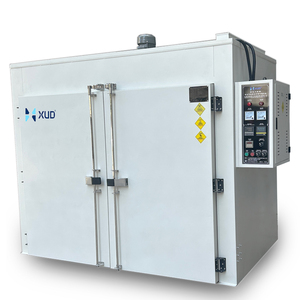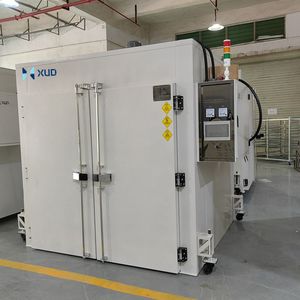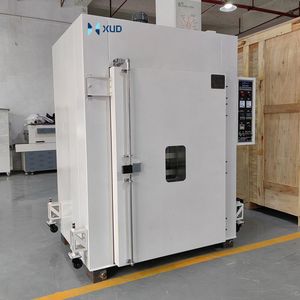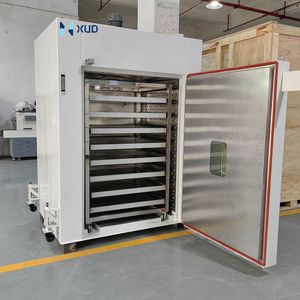
All categories
Featured selections
Trade Assurance
Buyer Central
Help Center
Get the app
Become a supplier

(77230 products available)














































Temperature humidity oven comes in various types. They include:
Memmert Type
A Memmert humidity chamber is a stable climate test chamber that meets testing requirements. It features a perfect airflow for an even distribution of temperature and humidity. It also comes with a water reservoir that enables automatic generation of mist for high-precision control of humidity. In addition, users can utilize the precision test atmosphere for predictive materials testing for medical and automotive applications.
Walk-In Types
A walk-in humidity testing room is a large, chamber, designed for big products or multiple units. It features adjustable temperature and humidity controls and allows operators to enter the space to inspect or work on test products. Commonly utilized in structural testing of large equipment, in aviation and automobile industries, these chambers also come in customized sizes to fit unique testing requirements. Despite its size, it still effectively simulates diverse climate conditions.
Reach-In Types
A reach-in humidity testing chamber is a small, environmental testing chamber designed for several products or small parts. It features adjustable temperature and humidity controls. Also, it can be used for testing products like electronic parts, materials, or small equipment in various industries. Its compact size and effectiveness in simulating diverse climate conditions make it a perfect option for environmental test chamber labs with limited space.
Binder Type
A BINDER humidity chamber is characterized by ultra-precision in temperature and humidity control. It includes the APT.line preheating system which ensures even distribution of temperature without creating draught. This exemplifies a highly accurate and reproducible testing atmosphere ideal for testing of pharmaceutical and plant growth products. Other features include a user-friendly control panel and energy efficiency that guarantee an optimal testing environment.
Temperature humidity ovens have variegated industry applications. They include:
Pharmaceuticals
In the pharmaceutical industry, these ovens are used for stability testing where they evaluate how drugs and other products react to varying temperatures and humidity over time. This ensures that products remain effective under designated storage conditions. Also, they assist in drying medical equipment and samples while maintaining a controlled atmosphere.
Automotive
In the variegated application of climatic test chambers in the automotive sector, they test how materials and components hold up to extreme humidity and temperature levels. These rapid cycles of heat and moisture help identify weaknesses in designs, such as materials that might degrade or lose elasticity over time. They aid outdoor simulation to ensure vehicles endure real-life elements and improve long-term reliability.
Aerospace
Aerospace industries use these ovens for testing components and materials to be sure they stand up to the harshest atmospheric conditions. Also, they are employed for testing how systems perform under elevated humidity and temperature levels, which are common at high altitudes. They ensure reliability of parts in-flight and safety, by simulating extreme environmental conditions that entail both the interior and the exterior of the aircraft.
Electronics
In the electronics industry, these temperature humidity ovens are important for testing how gadgets such as phones and computers respond to changes in climatic conditions. Exposure to combined heat and moisture can pinpoint potential failure cases like corrosion of internal components. These tests help manufacturers understand how their products react to diverse storage and usage conditions, thereby increasing performance and longevity.
Material Testing
In material testing, these ovens are used to analyze how different materials such as plastics and metals stand up to diverse humidity and temperature levels. They induce expansion and contraction in materials, which lead to the weakening of structures. Also, they assist in ascertaining such materials' viability for outdoor use where they undergo extreme environmental conditions. This helps in selection for applications requiring durability and dependability.
Some of the key features of a temperature humidity oven include:
Humidity Control
These ovens support precise control of humidity levels through a range of methods. One of these methods includes a water reservoir that adds moisture to the air. Another method is an ultra-dry air system that extracts moisture, thus producing low-humidity conditions. Moreover, advanced sensors measure and regulate humidity effectively, creating an accurate testing environment that meets specific requirements.
Controlling of Temperature
This oven has the ability to control temperature over a range of -10 to +60 degrees Celsius. It employs a powerful heating and cooling system to achieve this. Moreover, it uses a combination of heaters and refrigerant to maintain temperature levels and distribute it evenly throughout the chamber.
Large Capacity
These ovens are designed with expansive interiors that accommodate multiple samples or large products. The standard model features measurements of 1000 litres, though the size can be easily customized based on requirements. This makes it ideal for large testing batches in spaces that are small and densely populated.
Test Cycle
This oven incorporates test cycles enabling users to program a sequence of changing temperatures and humidity levels. These simulate real-world conditions for products being tested. This feature is useful for industries such as aerospace and automotive where stress tests under varied environmental conditions are crucial for product integrity.
Material
This oven is made from premium stainless steel, which affords it with durability and resistance to corrosion. The chamber is polished for easy cleaning and maintenance. This also ensures that it remains free from contaminants that may interfere with testing results.
When purchasing a temperature humidity oven, several factors should be considered. They include:
Application
One’s intended use greatly impacts the choice of the temperature-humidity oven. For instance, it is critical for the pharmaceutical industry to maintain precise humidity levels during stability testing. A humidity chamber with a high control precision will work best for such situations. On the other hand, automotive testing may require an oven with a broad range of temperature and humidity settings to simulate real-world environments.
Size and Capacity
It is important to assess both the size and capacity of the chamber. While smaller units may suffice for the laboratory with low samples, larger ovens would be necessary for large batches or oversized products. Moreover, ensure there is sufficient space for proper airflow to avoid stagnant conditions that may lead to uneven results.
Control and User Interface
The sophistication of the control system directly influences ease of use and accuracy. Seek out ovens featuring an intuitive digital interface enabling straightforward adjustments of temperature and humidity settings. Also, options for programming complex test profiles together with real-time monitoring could improve efficiency for advanced testing procedures.
Budget
The budget is also a critical consideration, since high-end models typically provide superior precision and durability. However, it may not always be necessary depending on the testing requirements. It is crucial to compare distinct features across models within the same price range. This ensures attainment of the required performance with provision of cost efficiency.
Maintenance Requirements
A prolonged lifespan of the temperature-humidity oven is guaranteed by low maintenance requirements. Look for models with easily accessible components for cleaning and servicing. Avoiding the corrosion of the chamber due to frequent exposure to high humidity will be aided by one that is constructed from stainless steel and has a durable, sealed design.
Which are the common industries that utilize a temperature humidity oven?
The common industries that utilize a environmental chamber for sale are distinct, with each considering such factors as specific testing needs, sample types, and environmental conditions. These industries include pharmaceuticals, where they test the stability of drugs; automotive for material testing and stress analysis, aerospace to test components for extreme conditions, electronics to simulate consumer usage scenarios, and materials for failure analysis. Additionally, they are also applicable in packaging for durability testing, and in laboratories for research into climate effects on diverse products.
Which are the key features in a temperature humidity oven?
Some key features that are integrated into temperature humidity test chambers include precise control of temperature and humidity, expansive capacity for accommodating multiple samples or large products, creation of test cycles enabling simulation of real-world conditions, and a standard construction of stainless steel for durability and easy maintenance. Also, they ensure provision of accurate and dependable environmental testing.
How does one choose the right temperature humidity oven?
Choice of the right temperature humidity oven depends on its intended use, size, and budget. Application greatly impacts the choice, since intended use determines precision and features required. While a smaller unit may suffice for the low samples laboratory, larger ovens would be necessary for oversized products. While high-end models typically provide superior precision and durability, a comparison of distinct features across models within the same price range will provide the required performance with provision of cost efficiency.
Can a temperature humidity oven be maintained, and what are its maintenance requirements?
Yes, temperature humidity ovens can be maintained with low maintenance requirements ensuring a prolonged lifespan. These such are made from stainless steel with durable, sealed designs that enclose them for easy accessibility and cleaning. High humidity frequently during usage necessitates corrosion-proof materials, and regular inspections of seals and sensors are also necessary to maintain optimal performance.